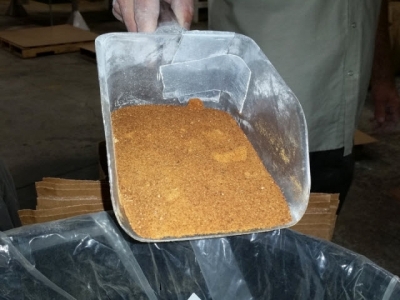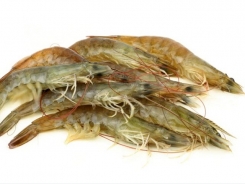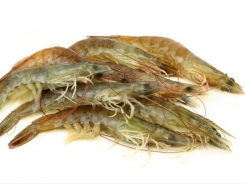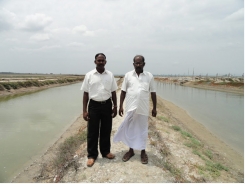Nutritional evaluation of improved soybean meal in Pacific white shrimp diets

Study shows potential for improved soybean meal as a potential fishmeal replacement in Pacific white shrimp diets.
Shrimp farming – the fastest growing aquaculture industry – is developing more rapidly than any other agricultural sector worldwide. There is increasing pressure on the use of marine fishmeal use in shrimp feed, and a significant need to maximize the use of alternative ingredients and minimize or eliminate the use of fishmeal.
Among potential alternative ingredients – and because of its availability, reasonable price, high digestibility and amino acid profile – conventional soybean meal is a most promising protein alternative due. However, conventional soybean meal has some limitations, and to overcome these, soybean producers are developing novel methods of producing improved soybean meal (ISBM) from conventional soybean meal. For example, the Ohio Soybean Council has developed an ISBM (EnzoMeal, Ohio Soybean Council/Battelle, Worthington, OH; ISBM) that contains about 20 percent more protein and 50 percent lower anti-nutritional factors (ANFs) vs. conventional soybean meal.
Globally, the Pacific white shrimp (Litopenaeus vannamei) is the most widely farmed shrimp species, and research to improve knowledge of its nutritional requirements is a priority.
We conducted this study to evaluate if improved soybean meal can be used to replace fishmeal in Pacific white shrimp feeds based on whole-body proximate composition, production performance, haemolymph metabolites and tail muscle fatty acid content.
(This article is adapted and summarized from the original Aquaculture Research. 49 (4), 1414-1422. We are grateful to the Ohio Soybean Council, USA for funding this research, to Alex Tsappis and Jackson Tucker (Alltech), and to Dr. Waldemar Rossi Jr. for their support.)

A view of the experimental tanks used in the study.
Study setup
We conducted a 12-week feeding trial at the Kentucky State University Aquaculture Research Center to evaluate a non-genetically modified, improved soybean meal (EnzoMeal, from Ohio Soybean Council/Battelle, Worthington, OH), in the diet of Pacific white shrimp. Our study followed the scientific research protocols of Kentucky State University (Frankfort, KY, USA) and complied with all relevant local and/or international animal welfare laws, guidelines and policies. A recirculating aquaculture system with twelve 1,000-liter polyethylene tanks, aeration and a mechanical filter was used.
Two-hundred juvenile shrimp (average initial weight: 3.2 grams) were stocked in each tank, and experimental diets were randomly assigned in triplicates. Shrimp were fed the experimental diets three times a day at rates of 3 to 4 percent of tank biomass, and feed amounts were adjusted every four weeks. Routine water quality parameters were monitored and maintained within acceptable ranges during the study.
Four experimental diets – isonitrogenous (40 percent crude protein) and isolipidic (9 percent lipid) – were formulated and manufactured at the Alltech feed manufacture facility in Winchester (KY, USA). The Ohio Soybean Council (EnzoMeal, Ohio Soybean Council/Battelle, Worthington, OH, USA) provided the improved soybean meal. Test diets include an improved soybean meal-free control diet (ISBM-0) with fishmeal at 300 g/kg as the major protein source, and three test diets (ISBM-33, ISBM-66 and ISBM-100) formulated to replace fishmeal with increasing levels of improved soybean meal. The resulting dry diets were coated with fish oil and stored refrigerated until used in the test.

The experimental diets preparation team.
Overall, the diets’ amino acid composition was similar although ISBM-66 and ISBM-100 displayed lower levels of lysine and methionine relative to ISBM-0 and ISBM-33. Crude protein was relatively constant across diets (402 to 416 g/kg), whereas wider differences were observed for lipid (86 to 102 g/kg).
Please refer to the original publication or contact the first author for a detailed description of the experimental diets used and their preparation, the growth trial, sampling and biochemical composition assays, and calculations and statistical analyses used in this study.
Results and discussion
Table 1 presents results of production performance of juvenile Pacific white shrimp fed diets containing graded levels of improved soybean meal for 12 weeks. Regarding the production performance, a significant difference was found for final weight only, with final weight significantly lower in the group-fed ISBM-66 vs. shrimp-fed ISBM-0. Weight gain, feed efficiency ratio, protein efficiency ratio and survival were not affected by the use of improved soybean meal (p > .05). Optimum replacement fishmeal with improved soybean meal was estimated to be 89.13 percent and 95.56 percent respectively, for final weight and weight gain.
Kumar, ISBM, Table 1
| Parameter | ISBM-0 | ISBM-33 | ISBM-66 | ISBM-100 |
| Initial weight (g) | 3.25±0.02 | 3.24±0.02 | 3.24±0.02 | 3.23±0.01 |
| Final weight (g) | 25.58±0.87b | 24.10±0.32a,b | 22.26±0.85a | 22.40±0.68a,b |
| Weight gain (%) | 688.00±25.01 | 645.00±14.00 | 587.00±26.63 | 592.67±21.67 |
| Feed efficiency ratio | 0.59±0.01 | 0.60±0.01 | 0.56±0.01 | 0.58±0.02 |
| Protein efficiency ratio | 1.21±0.03 | 1.15±0.02 | 1.13±0.03 | 1.15±0.05 |
| Survival (%) | 81.67±2.35 | 82.50±1.80 | 81.83±3.84 | 83.67±0.83 |
Table 1. Production performance of juvenile Pacific white shrimp fed with diets containing graded levels of improved soybean meal (ISBM).
Regarding whole-body proximate chemical composition, the improved soybean meal replacement significantly affected moisture and protein of the shrimp, whereas lipid and ash were not significantly influenced by the diets. The group fed ISBM-100 had significantly higher moisture and lower protein content vs. animals fed ISBM-0, but there were no other significant differences among the treatments.
Regarding cholesterol and fatty acids composition in the tail muscle, no significant differences were found in tail muscle cholesterol content. Replacement of fishmeal with improved soybean meal significantly influenced the linoleic, linolenic and oleic acids, and omega-6 polyunsaturated fatty acid (PUFA) levels in shrimp tail muscle. There were no significant differences in the composition of EPA, DHA, ARA and the other major fatty acids or the omega-3/omega-6 ratios among the groups (Fig. 1; p > .05).

Fig. 1: Linolenic acid (a), eicopentaenoic acid (b), docosahexaenoic acids (c), Σ omega-3 polyunsaturated fatty acids and (d) of juvenile Pacific white shrimp fed experimental diets with graded levels of improved soybean meal. Data are mean ± SE for three replicates, and mean values with different small letters above the bar are significantly different (p < .05)
Results of our study indicate that improved soybean meal has potential to be an alternative ingredient used in the diet of Pacific white shrimp and replace fishmeal. All diets evaluated produced acceptable production performance of juvenile Pacific white shrimp, and no significant differences were observed among the treatment groups except the group-fed ISBM-66 had lower final weight than the control group. From our results, it appears that complete replacement of fishmeal with improved soybean meal is viable without unfavorably affecting the growth performance of Pacific white shrimp.

Periodic sampling of the experimental animals for data collection.
Numerous studies have also assessed the suitability of several ingredients for total or partial replacement of fishmeal with plant-based protein sources in shrimp diets, and most reported that partial replacement of fishmeal with conventional soybean meal could be due to high level of ANF in conventional soybean meal.
However, our study showed that total replacement of fishmeal with improved soybean meal could be possible without unfavorably influencing shrimp production, which could be caused by low levels of ANF in the improved soybean meal compared with conventional soybean meal. In our study, complete replacement of fishmeal with improved soybean meal significantly affected shrimp protein and moisture content but did not affect ash or lipid. Therefore, a low level of animal-based protein sources may be required in Pacific white shrimp diets that are completely based on improved soybean meal.

Harvesting shrimp at the end of the study, for final sample analysis and data collection.
We found no significant differences in EPA, DHA and omega-3s among the shrimp, which suggests that improved soybean meal can potentially be used to completely replace fishmeal as a source of omega-3 fatty acids in shrimp diets. And the replacement of fishmeal with improved soybean meal did not result in significant differences in omega-3/omega-6 ratios in the muscle tail of Pacific white shrimp, so improved soybean meal could potentially be used to replace fishmeal in shrimp feeds without unfavorably changing product quality. However, the specific molecular mechanisms behind these findings need further study.
We observed no significant differences in haemolymph glucose, albumin, globulin and total protein in juvenile PWS among the treatments, in comparison to previous studies showing lower protein and higher glucose in the haemolymph of whiteleg shrimp fed a diet with increasing levels of conventional soybean meal as a replacement for fishmeal. We believe further studies are needed.
Perspectives
In conclusion, based on the production performance results, specifically the second-degree polynomial regression analysis of final weight and weight gain, the estimated optimum level of improved soybean meal to replace fishmeal is 89.13 to 95.56 percent for Pacific white shrimp.
Our results suggest that alternative, sustainable plant protein sources like improved soybean meal could totally replace fishmeal in Pacific white shrimp diets without negatively affecting product quality or production performance. Information from our study also support the potential of Pacific white shrimp to use alternative ingredients with low levels of animal-based protein sources, thus supporting the sustainable aquaculture production of this shrimp species.
References available from corresponding author.
About Authors:
RICHARD HULEFELD
- Division of Aquaculture
- College of Agriculture, Food Science and Sustainable Systems (CAFSSS)
- Kentucky State University
- Frankfort, KY, USA
HABTE-MICHAEL HABTE-TSION, PH.D.
- Division of Aquaculture, College of Agriculture, Food Science and Sustainable Systems (CAFSSS)
- Kentucky State University
- Frankfort, KY, USA
RAMANATHAN S. LALGUDI, PH.D.
- Battelle Memorial Institute, Columbus, OH, USA
BARRY MCGRAW
- Ohio Soybean Council, Worthington, OH, USA
ROB CAIN, PH.D.
- Battelle Memorial Institute, Columbus, OH, USA
KRISTY ALLEN, M.SC.
- Division of Aquaculture
- College of Agriculture, Food Science and Sustainable Systems (CAFSSS)
- Kentucky State University
- Frankfort, KY, USA
KENNETH R. THOMPSON, M.SC.
- Division of Aquaculture
- College of Agriculture, Food Science and Sustainable Systems (CAFSSS)
- Kentucky State University
- Frankfort, KY, USA
JAMES H. TIDWELL, PH.D.
- Division of Aquaculture
- College of Agriculture, Food Science and Sustainable Systems (CAFSSS)
- Kentucky State University
- Frankfort, KY, USA
VIKAS KUMAR, PH.D.
- Corresponding author
- Division of Aquaculture
- College of Agriculture, Food Science and Sustainable Systems (CAFSSS)
- Kentucky State University
- Frankfort, KY, USA; and
- Hagerman Fish Culture Experiment Station
- University of Idaho
- Hagerman, ID, USA
Related news
Tools

Phối trộn thức ăn chăn nuôi

Pha dung dịch thủy canh

Định mức cho tôm ăn

Phối trộn phân bón NPK

Xác định tỷ lệ tôm sống

Chuyển đổi đơn vị phân bón

Xác định công suất sục khí

Chuyển đổi đơn vị tôm

Tính diện tích nhà kính

Tính thể tích ao




 Ongoing production issues in shrimp farming, part 1
Ongoing production issues in shrimp farming, part 1  Improving shrimp farm design in flood-prone areas of…
Improving shrimp farm design in flood-prone areas of…